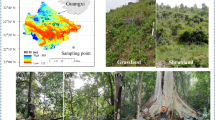Abstract
The correct evaluation of the age of small tree individuals is of great importance in ecological studies, and can be performed if growth units are identifiable even under strong environmental constraints. We aimed to assess the reliability of age evaluation of small individuals of four species commonly occurring at the treeline in the Alps and the Apennines (N Italy), Picea abies, Pinus cembra, Larix decidua and Fagus sylvatica. A total of 224 individuals were sampled along an altitudinal gradient up to the treeline. For each species, we assessed the growth architecture and the appearance of annual growth units; for each individual, age and evaluation uncertainty were estimated. To verify the estimation a core or a cross-section was obtained. The estimated age was compared with the tree-ring age through linear regression and reduced chi square test, and the estimation accuracy was evaluated as function of tree age, dimension and environmental parameters. A good estimation was possible for all species, even when loss of vertical growth occurred. The highest error occurred for Larix, the lowest for Pinus; the error was generally correlated with tree age and dimension, and was affected by altitude and geomorphology. Good reduced chi square values were reached considering only the youngest individuals for Fagus and Picea and the smallest for Fagus and Larix; the uncertainty was generally underestimated for Pinus. Even though reliable age estimation could be obtained, a realistic and species-specific evaluation of the estimation uncertainties is necessary to assess estimation accuracy for ecological studies.








Similar content being viewed by others
References
Batllori E, Gutierrez E (2008) Regional tree line dynamics in response to global change in the Pyrenees. J Ecol 96:1275–1288
Batllori E, Camarero JJ, Ninot JM, Gutierrez E (2009) Seedling recruitment, survival and facilitation in alpine Pinus uncinata tree line ecotones. Implications and potential responses to climate warming. Global Ecol Biogeogr 18:460–472
Bégin C, Filion L (1999) Black spruce (Picea mariana) architecture. Can J Bot 77:664–672
Bell AD (1991) Plant form. An illustrated guide to flowering plant morphology. Oxford University Press, Oxford
Caccianiga M, Payette S (2006) Recent advance of white spruce (Picea glauca) in the coastal tundra of the eastern shore of Hudson Bay (Québec, Canada). J Biogeogr 33:2120–2135
Caccianiga M, Andreis C, Armiraglio S, Leonelli G, Pelfini M, Sala D (2008) Climate continentality and treeline species distribution in the Alps. Plant Biosyst 142:66–78
Camarero JJ, Gutierrez E (2004) Pace and pattern of recent treeline dynamics: response of ecotones to climatic variability in the Spanish Pyrenees. Clim Change 63:181–200
Farrar JL (1995) Trees of the Northern United States and Canada. Iowa State University Press, Iowa
Gutsell SL, Johnson EA (2002) Accurately ageing trees and examining their height-growth rates: implications for interpreting forest dynamics. J Ecol 90:153–166
Hallé F (2004) Architectures des plantes. JPC Editions
Hallé F, Oldeman RAA (1970) Essai sur l’architecture et la dynamique de croissance des arbres tropicaux. Masson et Cie, Paris
Hallé F, Oldeman RAA, Tomlinson PB (1978) Tropical trees and forests. An architectural analysis. Springer, Berlin
Harsch MA, Hulme PE, McGlone MS, Duncan RP (2009) Are treelines advancing? A global meta-analysis of treeline response to climate warming. Ecol Lett 12:1040–1049
Hättenschwiler S, Smith WK (1999) Seedling occurrence in alpine treeline conifers: a case study from the central Rocky Mountains, USA. Acta Oecol 20:219–224
Holtmeier FK (2003) Mountain timberlines. Ecology, patchiness, and dynamics. Advances in global change research, volume 14. Kluwer, Dordrecht
Koch J (2009) Improving age estimates for late Holocene glacial landforms using dendrochronology—Some examples from Garibaldi Provincial Park, British Columbia. Quater Geochronol 4(2009):130–139
Laberge MJ, Payette S, Pitre N (2001) Development of stunted black spruce (Picea mariana) clones in the subarctic environment: a dendro-architectural analysis. Ecoscience 8:489–498
Mayer H (1974) Wälder der Ostalpenraumes. Gustav Fischer, Jena
McCarthy DP, Luckman BH, Kelly PE (1991) Sampling height-age error correction for spruce seedlings in glacial forefields, Canadian Cordillera. Arct Alp Res 23:451–455
Mougin E, Lopes A, Karam MA, Fung AK (1993) Effect of tree structure on X-band microwave signature of conifers. IEEE T Geosci Remote 31:655–667
Mutke S, Sievänen R, Nikinmaa E, Perttunen J, Gil L (2005) Crown architecture of grafted stone pine (Pinus pinea L.): shoot growth and bud differentiation. Trees Struct Funct 19:15–25
Paulsen J, Weber UM, Körner C (2000) Tree growth near treeline: abrupt or gradual reduction with altitude? Arct Antarct Alp Res 32:14–20
Payette S, Delwaide A, Morneau C, Lavoie C (1996) Patterns of tree stem decline along a snow-drift gradient at treeline: a case study using stem analysis. Can J Bot 74:1671–1683
Pereg D, Payette S (1998) Development of black spruce growth forms at treeline. Plant Ecol 138:137–147
Peters VS, Macdonald SE, Dale MRT (2002) Aging discrepancies of white spruce affect the interpretation of static age structure in boreal mixedwoods. Can J For Res 32:1496–1501
Pezzi G, Ferrari C, Corazza M (2008) The altitudinal limit of beech woods in the Northern Apennines (Italy). Its spatial patterns and some thermal inferences. Folia Geobot 43:443–459
Robinson DF (1996) A symbolic framework for the description of tree architecture models. Bot J Linn Soc 121:243–261
Taylor JR (1982) An introduction to error analysis. The study of uncertainties in physical measurements. University Science Books, Sausalito
Tranquillini W (1979) Physiological ecology of the alpine timberline. Springer, Berlin
Wiegand T, Camarero JJ, Ruger N, Gutierrez E (2006) Abrupt population changes in treeline ecotones along smooth gradients. J Ecol 94:880–892
Wong CM, Lertzman KP (2001) Errors in estimating tree age: implications for studies of stand dynamics. Can J For Res 31:1262–1271
Acknowledgments
The authors are grateful to Silvia Cisani, Martino De Capitani, Silvia Ladina, Arianna Rossi, Duccio Tampucci and Lorenzo Caccianiga for assistance on the field and in the analyses, and to two anonymous referees for thoughtful comments.
Author information
Authors and Affiliations
Corresponding author
Additional information
Communicated by S. Mayr.
Rights and permissions
About this article
Cite this article
Caccianiga, M., Compostella, C. Growth forms and age estimation of treeline species. Trees 26, 331–342 (2012). https://doi.org/10.1007/s00468-011-0595-1
Received:
Revised:
Accepted:
Published:
Issue Date:
DOI: https://doi.org/10.1007/s00468-011-0595-1




